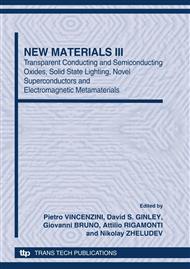p.25
p.31
p.36
p.43
p.49
p.55
p.65
p.74
p.79
Analysis on Resistive Switching of Resistive Random Access Memory Using Visualization Technique of Data Storage Area with Secondary Electron Image
Abstract:
Both a low and a high resistance states which were written by the voltage application in a local region of NiO/Pt films by using conducting atomic force microscopy (C-AFM) were observed by using scanning electron microscope (SEM) and electron probe micro analysis (EPMA). The writing regions are distinguishable as dark areas in a secondary electron image and thus can be specified without using complicated sample fabrication process to narrow down the writing regions such as the photolithography technique. In addition, the writing regions were analyzed by using energy dispersive X-ray spectroscopy (EDS) mapping. No difference between the inside and outside of the writing regions is observed for all the mapped elements including C and Rh. Here, C and Rh are the most probable candidates for contamination which affect the secondary electron image. Therefore, our results suggested that the observed change in the contrast of the secondary electron image is related to the intrinsic change in the electronic state of the NiO film and a secondary electron yield is correlated to the physical properties of the film.
Info:
Periodical:
Pages:
49-54
Citation:
Online since:
October 2010
Keywords:
Price:
Сopyright:
© 2010 Trans Tech Publications Ltd. All Rights Reserved
Share:
Citation:


